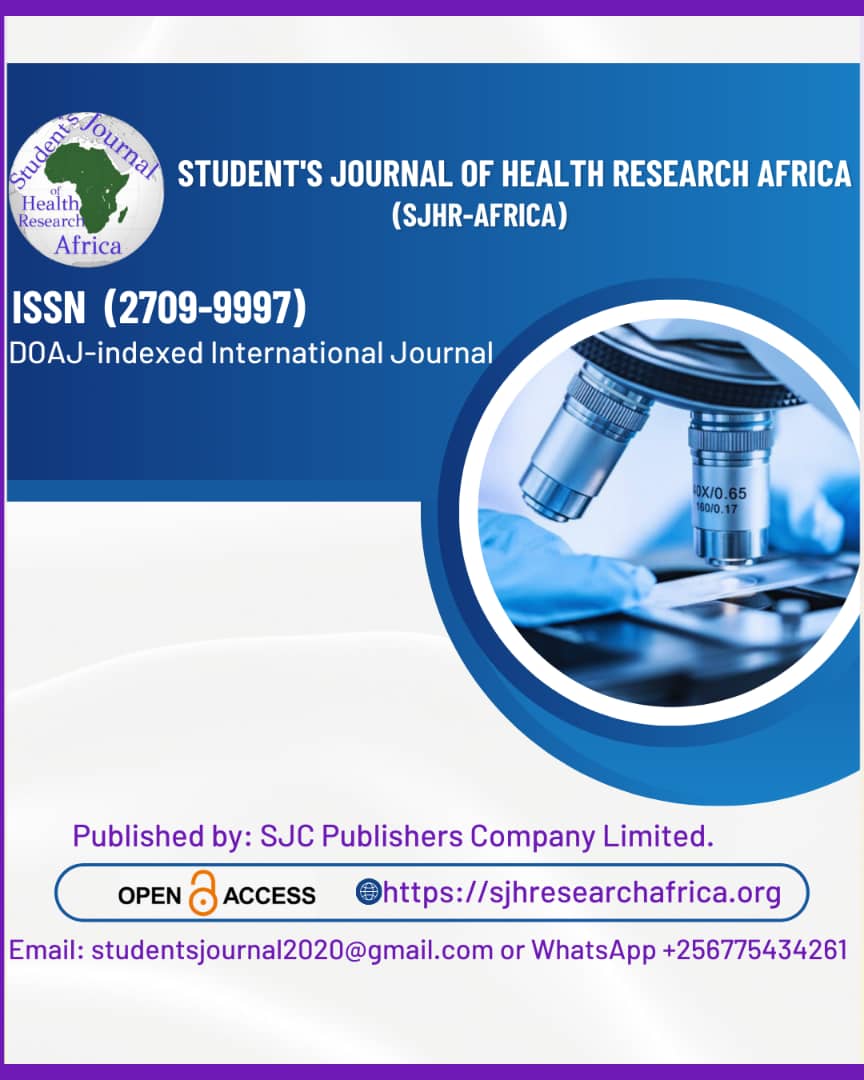Phenotypic and genotypic characterization of vancomycin-resistant enterococcus isolates from clinical specimens: A cross-sectional study.
DOI:
https://doi.org/10.51168/sjhrafrica.v6i9.2147Keywords:
Vancomycin-resistant Enterococcus, vanA gene, Antimicrobial resistance, Hospital-acquired infection, monalisa et alAbstract
Background
Enterococci are Gram-positive bacteria that form part of the human gut flora but have emerged as significant nosocomial pathogens. The increasing prevalence of vancomycin-resistant enterococci (VRE) poses major therapeutic and infection-control challenges. This study aimed to determine the prevalence of vancomycin resistance among clinical Enterococcus isolates and to characterize the associated phenotypic and genotypic resistance profiles.
Methodology
A cross-sectional study was conducted in the Department of Microbiology, MKCG Medical College and Hospital, Berhampur, Odisha, from October 2017 to September 2019. One hundred non-duplicate Enterococcus isolates recovered from urine, blood, pus/wound swabs, and sterile body fluids were identified based on standard biochemical tests. Antimicrobial susceptibility was performed using the Kirby–Bauer disc diffusion method as per CLSI 2019 guidelines. Vancomycin resistance was screened on VRE agar and confirmed by MIC via E-test. Genotypic detection of vanA and vanB resistance genes was performed using multiplex real-time PCR. Basic demographic variables, including age and sex, were recorded.
Results
Of the 100 isolates, 64% were E. faecalis, 31% were E. faecium, and 5% were E. durans. The mean age of affected patients was 38.6 years, with a female predominance (56%). The prevalence of VRE was 23%, with E. faecium accounting for most resistant isolates (69.6%). VRE isolates demonstrated high resistance to ampicillin (100%), ciprofloxacin (95.7%), high-level gentamicin (82.6%), and teicoplanin (78.3%), while all isolates remained susceptible to linezolid. All VRE isolates carried the vanA gene; vanB was not detected. Heteroresistance was identified in five isolates.
Conclusion
vanA-mediated VRE is prevalent in hospital settings and associated with multidrug resistance.
Recommendation
Routine surveillance, molecular detection, and strengthened antimicrobial stewardship are essential to limit VRE dissemination.
References
Murray BE. The life and times of the Enterococcus. Clin Microbiol Rev. 1990;3(1):46-65.
https://doi.org/10.1128/CMR.3.1.46
PMid:2404568 PMCid:PMC358140
Fisher K, Phillips C. The ecology, epidemiology and virulence of Enterococcus. Microbiology. 2009;155(Pt 6):1749-57.
https://doi.org/10.1099/mic.0.026385-0
PMid:19383684
Hidron AI, Edwards JR, Patel J, Horan TC, Sievert DM, Pollock DA, et al. NHSN annual update: antimicrobial-resistant pathogens associated with healthcare-associated infections. Infect Control Hosp Epidemiol. 2008;29(11):996-1011.
https://doi.org/10.1086/591861
PMid:18947320
Cetinkaya Y, Falk P, Mayhall CG. Vancomycin-resistant enterococci. Clin Microbiol Rev. 2000;13(4):686-707.
https://doi.org/10.1128/CMR.13.4.686
PMid:11023964 PMCid:PMC88957
Uttley AH, Collins CH, Naidoo J, George RC. Vancomycin-resistant enterococci. Lancet. 1988;1(8575-6):57-8.
https://doi.org/10.1016/S0140-6736(88)91037-9
PMid:2891921
DiazGranados CA, Zimmer SM, Klein M, Jernigan JA. Comparison of mortality associated with vancomycin-resistant and vancomycin-susceptible enterococcal bloodstream infections: a meta-analysis. Clin Infect Dis. 2005;41(3):327-33.
https://doi.org/10.1086/430909
PMid:16007529
Weigel LM, Clewell DB, Gill SR, Clark NC, McDougal LK, Flannagan SE, et al. Genetic analysis of a high-level vancomycin-resistant Staphylococcus aureus isolate. Science. 2003;302(5650):1569-71.
https://doi.org/10.1126/science.1090956
PMid:14645850
Courvalin P. Vancomycin resistance in gram-positive cocci. Clin Infect Dis. 2006;42 Suppl 1:S25-34.
https://doi.org/10.1086/491711
PMid:16323116
Arthur M, Courvalin P. Genetics and mechanisms of glycopeptide resistance in enterococci. Antimicrob Agents Chemother. 1993;37(8):1563-71.
https://doi.org/10.1128/AAC.37.8.1563
PMid:8215264 PMCid:PMC188020
Périchon B, Courvalin P. VanA-type vancomycin-resistant Enterococcus faecalis. Antimicrob Agents Chemother. 2009;53(11):4568-75.
https://doi.org/10.1128/AAC.00346-09
PMid:19506057 PMCid:PMC2772335
CLSI. Performance standards for antimicrobial susceptibility testing. 27th ed. CLSI supplement M100. Wayne, PA: Clinical and Laboratory Standards Institute; 2017.
Depardieu F, Podglajen I, Leclercq R, Collatz E, Courvalin P. Modes and modulations of antibiotic resistance gene expression. Clin Microbiol Rev. 2007;20(1):79-114.
https://doi.org/10.1128/CMR.00015-06
PMid:17223624 PMCid:PMC1797629
Vanover-Sams CL, Carroll KC, Tenover FC. Epidemiology and clinical significance of vancomycin-resistant enterococci. Clin Microbiol Rev. 2001;14(3):513-528.
Arias CA, Murray BE. The rise of the Enterococcus: beyond vancomycin resistance. Nat Rev Microbiol. 2012;10(4):266-278.
https://doi.org/10.1038/nrmicro2761
PMid:22421879 PMCid:PMC3621121
Leclercq R, Derlot E, Duval J, Courvalin P. Plasmid-mediated resistance to vancomycin and teicoplanin in Enterococcus faecium. N Engl J Med. 1988;319:157-161.
https://doi.org/10.1056/NEJM198807213190307
PMid:2968517
Mundy LM, Sahm DF, Gilmore M. Relationships between enterococcal virulence and antimicrobial resistance. Clin Microbiol Rev. 2000;13(4):513-522.
https://doi.org/10.1128/CMR.13.4.513
PMid:11023953 PMCid:PMC88945
Hollenbeck BL, Rice LB. Intrinsic and acquired resistance mechanisms in enterococcus. Virulence. 2012;3(5):421-433.
https://doi.org/10.4161/viru.21282
PMid:23076243 PMCid:PMC3485979
Flokas ME, Karageorgos SA, Alevizakos M, Kalbasi A, Mylonakis E. Vancomycin-resistant enterococci colonization, risk factors and risk for infection: a systematic review and meta-analysis. J Infect. 2017;74(6):531-544.
Willems RJ, van Schaik W. Transition of enterococci from commensals to leading causes of drug-resistant infection. Curr Opin Microbiol. 2009;12(4):430-436.
Pantosti A, Venditti M. Antimicrobial resistance in enterococci: a global overview. Int J Antimicrob Agents. 2009;33(4):321-330.
Chow JW, Fine MJ, Shlaes DM, et al. Enterococcal infections: clinical epidemiology, microbiology, and treatment. Clin Infect Dis. 1997;24(4):621-632.
Leclercq R. Mechanisms of resistance to macrolides and lincosamides: an overview. Clin Infect Dis. 2002;34(1):18-25.
https://doi.org/10.1086/324626
PMid:11797175
Huycke MM, Sahm DF, Gilmore MS. Multiple-drug resistant enterococci: the nature of the problem and an agenda for the future. Emerg Infect Dis. 1998;4(2):239-249.
https://doi.org/10.3201/eid0402.980211
PMid:9621194 PMCid:PMC2640141
Rice LB. Emergence of vancomycin-resistant enterococci. Emerg Infect Dis. 2001;7(2):183-187.
https://doi.org/10.3201/eid0702.010205
PMid:11294702 PMCid:PMC2631700
Sievert DM, Ricks P, Edwards JR, et al. Antimicrobial-resistant pathogens associated with healthcare-associated infections: summary of data reported to the National Healthcare Safety Network. Infect Control Hosp Epidemiol. 2013;34(1):1-14.
https://doi.org/10.1086/668770
PMid:23221186
McKinnell JA, Singh RD, Miller LG. Vancomycin-resistant Enterococcus: a review of antimicrobial resistance mechanisms, epidemiology, and treatment. Clin Ther. 2011;33(11):1684-1694.
Downloads
Published
How to Cite
Issue
Section
License
Copyright (c) 2025 Monalisa Panigrahi, Bimoch Projna Paty, Banojini Parida

This work is licensed under a Creative Commons Attribution-NonCommercial-NoDerivatives 4.0 International License.





















